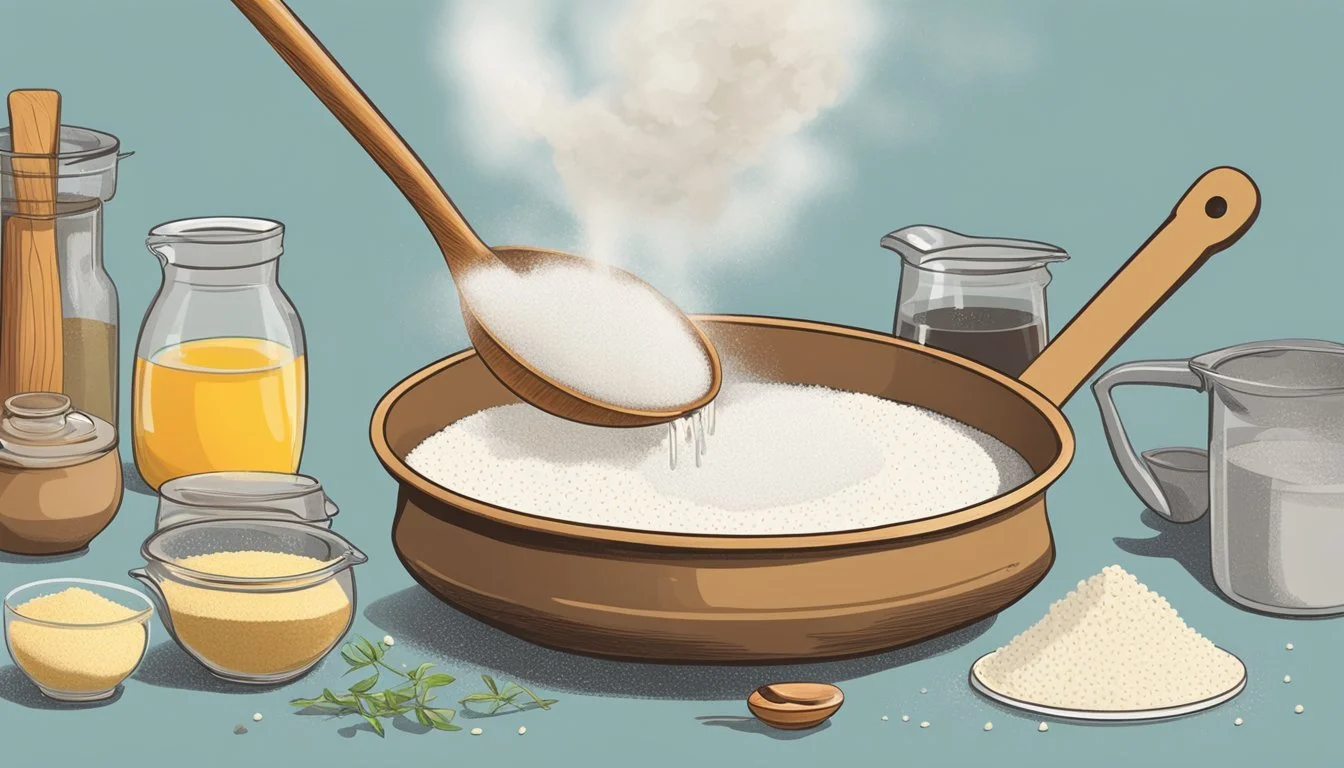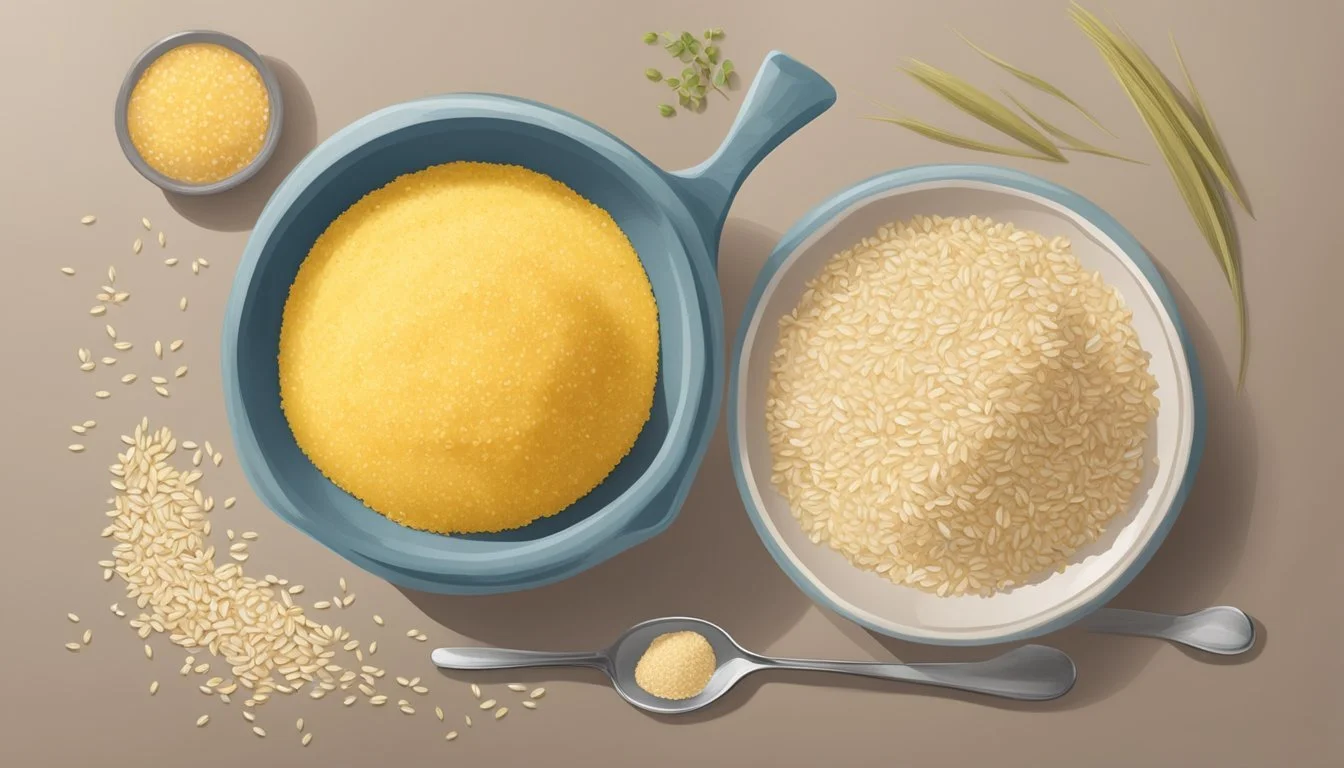Grits Substitutes
Top Alternatives for Your Southern Dishes
Grits have long been a Southern staple, often hailed as the ultimate comfort food. This coarsely ground cornmeal porridge holds a warm place in the hearts and kitchens across the Southern United States, commonly served as a side dish paired with ingredients ranging from savory cheese and shrimp to sweet butter and sugar. However, dietary preferences, availability, or a simple desire for variety may lead one to seek alternatives to traditional grits.
Substitutes for grits range from grains and vegetables to other forms of ground corn, each offering a texture or flavor profile that can complement the dishes that grits are typically paired with. Polenta, for instance, is a ground corn product like grits, but it generally has a finer texture and can serve as a nearly seamless swap in both consistency and taste. Other alternatives, such as cauliflower, offer a low-carbohydrate option, mimicking the texture of grits while providing additional nutritional benefits.
Couscous, another popular substitute, is a small pasta made from semolina wheat that brings a slightly nutty flavor and a light, fluffy texture to the table. It stands out due to its unique taste and could add an unexpected twist to dishes that conventionally feature grits. Finding the right substitute for grits depends on the desired outcome — whether it is replicating the original dish as closely as possible, adding nutritional value, or experimenting with new flavors and textures.
Understanding Grits
Grits are a traditional staple in Southern cuisine with a variety of textures and types available. They're derived from corn and are known for their versatility in dishes.
Grits Origins and Types
Grits hail from the Native American culinary tradition, where corn is processed through nixtamalization to produce hominy. The resulting hominy is then ground to create grits. The most common types of grits are:
Stone-ground grits: These grits come from the whole kernel, keeping the germ and hard starch. Due to less processing, they have a longer cooking time and a rich flavor.
Hominy grits: Made from hominy corn that has had the hull removed by nixtamalization.
Color varieties: Grits can be white or yellow, depending on the corn variety used, with white being milder and yellow having a more robust corn flavor.
Nutritional Value and Composition
A typical serving of grits is a source of energy due to its carbohydrates content. It usually has a low amount of fat and provides a modest number of calories per serving. The nutritional composition is as follows:
Calories: Approximately (^\star) 100-150 per cup
Carbohydrates: Predominant macronutrient
Fat: Low to negligible fat content
((^\star) Please verify exact values as they can vary by specific product and preparation method)
Choosing the Right Grits Texture
The texture of grits can affect the final dish significantly. Grits are classified based on their grinding size:
Coarse: Offers a more granular texture and takes longer to cook.
Medium: A balance between fine and coarse, providing a good blend of texture and flavor.
Fine: Delivers a smoother consistency and cooks more quickly.
The choice between fine, medium, or coarse grits will depend on one's desired texture in the finished dish. Chefs and cooking enthusiasts select the texture based on the recipe requirements and their personal preference for a particular granular feel.
Culinary Considerations
When substituting grits in cooking, one should consider the impact on flavor and the suitability for various meals, aiming to match the expected taste and texture profiles appropriately.
Flavor Enhancement with Grits
Replacing grits with alternative ingredients can affect the overall flavor of a dish. Attention to detail is required to ensure a pleasing taste. For instance:
Cheese: Adding cheese to substitutes like polenta can emulate the creamy flavorful essence of traditional cheese grits. Different cheeses such as cream cheese, parmesan, or cheddar can be utilized to add depth. Polenta with parmesan imparts a nutty, salty profile, whereas cheddar offers a sharper, more pronounced taste.
Herbs: Herbs such as thyme can complement the flavor of grits substitutes. When preparing a grits alternative like cauliflower grits or cornmeal porridge for breakfast, integrating thyme can enhance the savory element of the dish.
Grits in Different Meals
Grit substitutions should account for the meal type and the role that grits play within it:
Breakfast: For a breakfast dish, cauliflower grits can stand in for traditional grits, providing a lower-carb option that pairs excellently with eggs and bacon. The texture should be akin to soft-cooked grits, with possible additions like cream cheese to achieve a rich consistency.
Lunch and Dinner: In soups, stews, and chili, a grits substitute needs to withstand extended cooking and contribute to the dish's body. Couscous, with its light texture, can be added to lunch meals such as soups, adding a unique twist while maintaining a desirable thickness without overpowering the main ingredients.
Using the right substitute in appropriate contexts allows for a seamless culinary experience across various meals, retaining the heartiness of grits while adapting to specific dietary preferences and textural desires.
Grits Alternatives
When seeking out substitutes for grits, one must consider factors such as dietary restrictions, desired texture, and preparation time to select an appropriate alternative.
Substitutes for Different Preferences
For those with specific dietary needs, gluten-free and vegan options are available. Polenta, made from ground cornmeal, is gluten-free and resembles the taste and texture of grits, making it a suitable choice for individuals with gluten intolerance. For a vegan and allergen-friendly option, cornmeal is versatile and can be prepared to mirror the granularity of grits without compromising on taste.
Substitutes Based on Texture
Texture is a crucial aspect when replacing grits in a dish. Substitutes can range from coarse to powdery in consistency:
Coarse: Polenta offers a similar coarseness and is often interchangeable with grits.
Powdery: Finely ground cornmeal results in a smoother consistency but can still be used for a grits-like dish.
Substitutes Based on Cooking Time
Different substitutes possess varying cooking times, which can be a deciding factor for meal prep:
Quick Prep: Couscous is fast to prepare with a total cook time of approximately 5 minutes, providing a granular substitute for grits without lengthy preparation.
Longer Cook Time: Polenta requires a longer cook time compared to instant grits, usually around 45 minutes, but it can be a valuable alternative when time is not a constraint.
Each substitute brings its unique qualities to a dish and should be chosen based on one’s specific needs and preferences.
Common Grits Substitutes
When seeking alternatives to grits, consumers have a variety of grain-based options and creative substitutes that offer similar textures and flavors, suitable for different dishes.
Grain-Based Substitutes
Polenta: A classic Italian dish made from corn, polenta is closely related to grits. Its texture and taste are similar, but it often has a slightly finer consistency. Polenta can be an excellent one-for-one substitute in many recipes that call for grits.
Cornmeal: Diverse in texture, cornmeal can range from fine to coarse. Coarse-ground cornmeal most closely resembles the texture of grits and is suitable for making a porridge-like dish.
Oatmeal and Oats: While differing in flavor, oatmeal can be used as a substitute for a hearty and nutritious breakfast option. They can offer a comforting texture, albeit distinct from that of grits.
Other Creative Alternatives
Couscous: Made from semolina, couscous has small, granular particles that can mimic the texture of grits when cooked. It possesses a unique, slightly nutty flavor, offering a different twist to dishes traditionally made with grits.
Quinoa: With its fluffy texture upon cooking, quinoa is a healthy and protein-rich alternative. It can serve as an interesting textural substitute in meals that typically feature grits.
Semolina: As the coarser version of wheat, semolina can replace grits in cooking, providing a similar starchy base for recipes.
Cream of Wheat: Made from ground wheat, Cream of Wheat provides a smoother texture but can stand in for grits, especially in breakfast dishes.
Each of these substitutes has its own characteristics and flavors that can complement or enhance a variety of recipes, giving cooks the flexibility to adapt dishes according to availability or dietary preferences.
Storage and Shelf Life
Optimal storage methods can greatly extend the shelf life of grits and their common substitutes. This ensures both flavor and texture are preserved for the best culinary experience.
Proper Storage for Grits and Substitutes
Grits, made from hominy or dry, ground corn, typically come with a best-by date, but proper storage can extend their usability. Unopened, dry grits should be kept in a cool, dark, and dry place. Once opened, they should be transferred to an airtight container to prevent moisture and pests from spoiling them.
Stone-ground Grits: These have a shorter shelf life due to their minimal processing. Keep them refrigerated.
Instant Grits: They last longer than stone-ground variants and can be stored in your pantry.
Substitutes like polenta and cornmeal, which are similarly derived from corn, also benefit from being stored in airtight containers. Their texture, which is finer in polenta and more varied in cornmeal, is best maintained when kept away from humidity and temperature fluctuations.
Maximizing Freshness and Quality
To ensure your grits and their substitutes maintain their distinctive textures and flavors for as long as possible:
Use Mylar bags with oxygen absorbers for long-term storage of uncooked grits, extending their shelf life potentially up to 30 years.
Freeze cooked grits to preserve them for up to 6 months. Freeze in portions to avoid repeated thawing and freezing.
For substitutes like polenta, store them as you would grits, but if you purchase them in log form, wrap them tightly in plastic and refrigerate.
Utilizing these storage tips helps maintain the quality and extends the shelf life of both grits and their substitutes.
Cooking Tips and Tricks
When considering substitutes for grits, it's important to recognize the nuances in preparation methods and the potential for diverse flavor pairings. This can ensure the alternatives not only mimic the texture but also complement the overall taste profile of the dishes they are used in.
Preparation Techniques
Polenta, a popular alternative to grits, can be cooked in a similar fashion. It usually requires a simmering process wherein the polenta is gradually whisked into boiling water or broth, then cooked until it reaches the desired consistency. Prep time and cook time are crucial; one should allow about 5 minutes for prep and about 30 to 40 minutes for cooking, stirring frequently.
For cornmeal, which is finer than grits, the cook needs to adjust the liquid ratio to achieve the desired thickness. It’s a versatile base able to be adapted into porridge or used as a thickening agent in soups and stews.
Cauliflower grits offer a low-carb substitute, with the prep involving grating the cauliflower before cooking. The cook time is significantly reduced, making it a quick alternative with a prep time of about 10 minutes and a cook time of 5 to 10 minutes.
Flavor Pairings and Combinations
Substitutes for grits can be enhanced with the right flavor pairings. Here's how to complement their flavors:
Polenta: Pairs well with cheese, especially parmesan or gorgonzola, for a rich and creamy dish.
Cornmeal: Can be mixed with herbs such as thyme or rosemary to add a depth of flavor.
Cauliflower: Takes on flavors well; try combining with garlic and cheese for a moreish side dish.
One can add milk to both polenta and cornmeal during cooking for a creamier texture or a splash of stock for a more savory note. The key is to taste as one goes, ensuring the balance of flavors complements the main dish.
Frequently Asked Questions
What are suitable substitutes for grits in terms of flavor and texture?
Polenta: Similar taste with a slightly finer texture.
Cornmeal: It shares the same corn-based origin, ensuring a close flavor match.
Couscous: Provides a nutty, slightly sweet taste with a light texture.
Is cornmeal interchangeable with grits?
No, as regular fine-grind cornmeal will not replicate the texture of grits. One specifically needs coarsely ground cornmeal, also known as hominy grits.
How does the cooking method of grits substitutes compare?
Alternatives like polenta and cornmeal follow similar cooking processes to grits, generally involving simmering the grains in water or broth until they reach the desired consistency.
Can the texture of grits substitutes significantly affect my dish?
Yes, it can. The texture is a crucial element in replicating the consistency of a dish that typically uses grits. It's essential to choose a substitute that offers a comparable mouthfeel.
How should I store grits substitutes?
Grits substitutes should be stored in airtight containers in a cool, dry place. This practice helps maintain their quality and extends their shelf-life.
Can any pasta be a good substitute for grits?
While not common, couscous, a pasta-like grain, can be used as a substitute due to its small size and the ability to take on flavors well, although the resulting dish will differ in flavor and texture.








